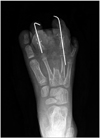Abstract
Macrodactyly is one of the most difficult congenital anomalies to treat. Treatment of macrodactyly requires surgical intervention because it gives rise to esthetic, social, and functional disability including difficulty in wearing shoes. A myriad of surgical techniques has been introduced to reduce the size of macrodactyly. However, treatment of toe macrodactyly has not been spotlighted due to less significant functional and social issues compared with finger macrodactyly. We treated two patients with toe macrodactyly by single stage reduction operation.
Figures and Tables
Figure 1
Feet of a 25-month old girl showed macrodactyly involving the second, third, and fourth toes. Note the size of shoes were fit to the affected right foot.

Figure 2
Radiograph of the right foot showed divergence of metatarsi. No osteochondral lesion was shown.

Figure 4
Nine years and six months after surgery, the second and fourth toes are still larger than those of the left foot. However, the proportion between the great toe and other toes improved.

Figure 5
Radiograph showed that bone union at the proximal phalangeal joints was achieved and the affected toes have a larger width at nine years and six months after surgery.

Figure 7
A six-year-old boy showed enlarged left third toe. The left third metatarsal and phalangeal bones did not show obviously enlarged bone.

References
2. Grogan DP, Bernstein RM, Habal MB, Ogden JA. Congenital lipofibromatosis associated with macrodactyly of the foot. Foot Ankle. 1991; 12:40–46.

3. Morrell NT, Fitzpatrick J, Szalay EA. The use of the Tsuge procedure for pedal macrodactyly: relevance in pediatric orthopedics. J Pediatr Orthop B. 2014; 23:260–265.
4. Topoleski TA, Ganel A, Grogan DP. Effect of proximal phalangeal epiphysiodesis in the treatment of macrodactyly. Foot Ankle Int. 1997; 18:500–503.

5. Ogino T. Macrodactyly. In : Buck-Gramko D, editor. Congenital malformations of the hand and forearm. London: Churchill-Livingstone;1998. p. 183–193.
6. Kim PT, Kim HS, Kim ID, Ogino T. Results of single stage reduction procedure for macrodactyly. J Korean Soc Surg Hand. 1997; 2:12–15.
7. Flatt AE. The care of congenital hand anomalies. 2nd ed. St. Louis: Quality Medical Publishing Inc.;1994. p. 47–62.
8. Chang CH, Kumar SJ, Riddle EC, Glutting J. Macrodactyly of the foot. J Bone Joint Surg Am. 2002; 84:1189–1194.

9. Hardwicke J, Khan MA, Richards H, Warner RM, Lester R. Macrodactyly: options and outcomes. J Hand Surg Eur Vol. 2013; 38:297–303.




 PDF
PDF ePub
ePub Citation
Citation Print
Print






 XML Download
XML Download